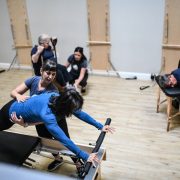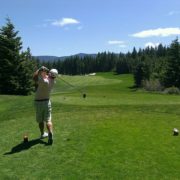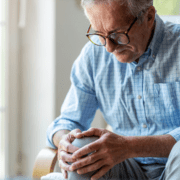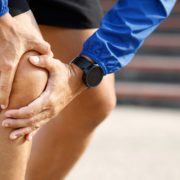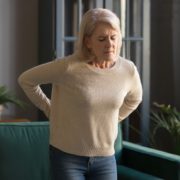The Right and Wrong Way to Strengthen Your Core
Good core strength is an important and vital component to life long health. Everyone knows that it’s an important factor in preventing low back pain, but having good core strength also helps you with your balance, overall stability, posture, and it can be crucial in helping you prevent injuries. Not only that, but when you have good core strength, you simply feel better, and have more confidence to do all the activities you love.
But when it comes to core strength, there’s a right and a wrong way about it.
And when you get it wrong, you’re looking at more back problems, pelvic health issues, and even neck and shoulder pain.
Here are some of the most common ways I see people getting core strength wrong – and what you can do to make it right:
1. All you do is crunches
Crunches are often considered to be a staple exercise when it comes to core strengthening. But growing evidence tells us that too many crunches may actually be detrimental to the health of your spine. When you perform an abdominal crunch – it typically involves lying on your back, bending your knees, and lifting your shoulders off the ground towards your knees.
This movement puts a lot of stress on your spine – especially when done incorrectly. If your core strengthening routine consists entirely of crunching – the repeated flexion of your spine will eventually lead to wear and tear on the discs in both your back and your neck.
What to do instead…
First – crunches aren’t “bad” for you. The problem is that people inherently do them wrong. I’ve been a back pain expert for over 10 years and I constantly see people doing this exercise incorrectly. If you’re going to incorporate crunches into your core strengthening routine – make sure you are doing them with proper form, proper technique, and with proper breathing. But even if you are doing crunches perfectly, you still need to include other exercises into your core strengthening routine. You have to balance out the forces on your spine and target other muscle groups that are equally important to a good, strong core.
Exercises such as planks, bird dogs, and bridges are some of my favorites. These exercises target your glutes and back muscles, and will reverse some of the stress caused by over-flexing of your spine.
2. You’re not breathing
You can’t activate your deep core if you don’t breathe properly. Your deep core consists of four parts: your deepest abdominal muscles; pelvic floor muscles, deepest back muscles, and your diaphragm. These four muscle groups work together to control intra-abdominal pressure – which is essential to facilitating a strong deep core connection. If something is off in this system, your intra-abdominal pressure will be distorted, which can create more pressure on structures such as your lumbar discs and pelvic floor region. Also, your bigger core muscles (like your outer abdominals, psoas, larger back muscles, and hips) will overwork or not work correctly.
What to do instead…
While there are good, better, and best ways to breathe when performing core exercises – I always say that when in doubt – just breathe. If you’re breathing, you give your deep core a fighting chance at activating properly. The reason being is because your diaphragm is your main breathing muscle. It relaxes and contracts with normal breath. When you hold your breath, your diaphragm stays contracted. That’s part of what disrupts the intra-abdominal pressure in your deep core. It’s also a good idea to incorporate Yoga or Pilates into your core routine. Both of these exercise practices emphasize breath as a central component and it can teach you how to breathe properly when exercising.
3. You aren’t incorporating rotational movements
Our bodies don’t interact with the world via straight-planed motions. We are constantly twisting, turning, and reacting to our environment in a variety of different ways. One of the biggest mistakes I see when it comes to core training is that people keep it very straight forward (no pun intended) and too simple. You can have a perfectly planned core strengthening routine that hits every muscle group but if you don’t challenge those muscle groups with different angles and combined multi-plane movements, your body gets lazy.
What to do instead…
Well, the obvious answer is to add rotational movements into your core routine.
But what does that look like?
You can add rotation as a challenge to almost anything. If you’re in a plank – rotate to your side and twist your arm up to the ceiling in between each rep. When you’re doing crunches – add cross body reaches each time you lift your head and chest. Rotational movements can also be incorporated into balance work – which inherently works your core.
Once you’ve mastered single leg activities – whether it be standing, stepping up, or lunging – you can add a twist or a reach to the end posture as you hold the movement. The possibilities are quite endless and you can get really creative. The point here is to not be “square”, and add variety to your core strengthening routine so that you mimic real life.
So how does your core strength training routine measure up? Have you been doing it right or wrong?
Here at CJPT & Pilates our favorite way to strengthen the core and whole body is through Pilates. If you’re struggling with pain or just getting started, I recommend consulting with an expert. They’ll be able to guide you in the right direction and set you up for success.
Are you local to Portsmouth, NH and interested in trying Pilates? CLICK HERE to schedule a call with one of my specialists. Learn more about Pilates and see if you would be a good fit!
Dr. Carrie Jose, Physical Therapist and Pilates expert, owns CJ Physical Therapy & Pilates in Portsmouth and writes for Seacoast Media Group. To get in touch, email her at [email protected].

